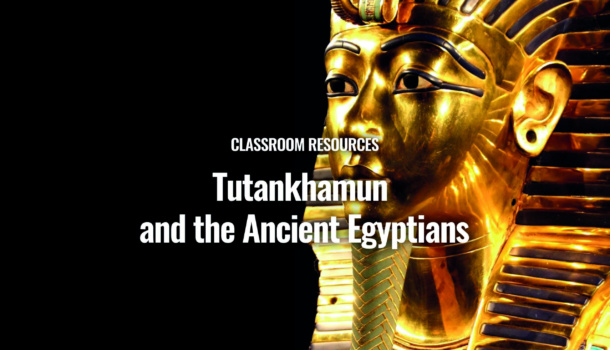Tutankhamun and the Ancient Egyptians
A range of teaching activities and learning resources based around the life and times of Ancient Egypt’s most famous pharaoh and one of history’s greatest discoveries – Tutankhamun.
Just as the belief of a curse brought people to visit Tutankhamun’s tomb 90 years ago, the interest in that curse has never diminished, particularly for children with active and enquiring minds.
The discovery of Tutankhamun’s tomb led to an interest in Ancient Egypt that still exists today. The topic is one that not only interests children, but excites their thirst for knowledge. What better topic to encourage active thinking skills than one where children are already eager to learn?
When Howard Carter opened Tutankhamun’s tomb, he could not have imagined the world’s media would descend upon the Valley of the Kings and report on the untold riches that were found. The contents of the tomb told people more about the lives of the ancient Egyptians than any other discovery.
The opening of the tomb was quickly followed by the death of Lord Carnarvon. This also excited interest and a media frenzy followed leading to the birth of the Tutankhamun curse.
Whether or not there is a curse interests people of all ages today. Is the curse a myth or fact, albeit a bacterial one? This provides the backdrop for a thinking skills topic that engages children from the minute they start to read of the discovery of the tomb and gives them the impetus to learn in a dynamic way.
This cross curriculum project includes:
‘Who was Tutankhamun?’ text (Open Access)
Did opening up the tomb of Tutankhamun really unleash a killer curse on Howard Carter and his team of unsuspecting archaeologists? Find out in this question-led text examining the dramatic discovery of the young pharaoh and his treasures. Available as a word document (formatted to make mass printing easier and more cost effective).
Activity 1: Time capsule (Open Access)
Students use a range of pictorial clues to make deductions about the contents of the text ‘Tutankhamun and the Ancient Egyptians’.
Includes instructions and:
- Activity sheet 1a: Student introduction
- Activity sheet 1b: Image clues
Activity 2: Anticipation guide
In this activity, children complete an ‘Anticipation guide’ before reading the text, ‘Tutankhamun and the Ancient Egyptians’, deciding which of the statements are true and which are false. They then read the text searching for specific evidence, encouraging them to read with purpose and engagement.
Includes instructions and:
- Activity sheet 2: Anticipation guide
Activity 3: Ancient Egypt timeline
Students put together a timeline of events in Ancient Egypt, working from the dates provided and sourcing the answers through independent research.
Includes instructions and:
- Activity sheet 3a: Student timeline template
- Activity sheet 3b: Teacher’s answer sheet
Activity 4: Temperature graphs
Students work collaboratively but independently to compare temperature and rainfall in Cairo and Great Britain. They then consider the implications of their findings in relation to the Ancient Egyptian way of life and the hunt for Tutankhamun’s tomb in the early 20th century.
Includes instructions and:
- Activity sheet 4a: Temperature and rainfall in Great Britain
- Activity sheet 4b: Temperature and rainfall in Cairo
- Activity sheet 4c: Comparing temperature and rainfall
Activity 5: Sahara food web
Students match up images depicting a range of creatures and plants from the Sahara Desert with their corresponding descriptions. They then construct a food web for the Sahara Desert.
Includes instructions and:
- Activity sheet 5a: Food web images
- Activity sheet 5b: Food web descriptions
- Activity sheet 5c: Student introduction
Activity 6: How did the Egyptians move sandstone blocks to build pyramids?
Students investigate how to overcome friction on a ramp. They investigate friction as a force that slows moving objects, how to measure force and how to identify the direction in which they act. They also investigate different methods of building potentially used in Ancient Egyptian times.
Includes instructions and:
- Activity sheet 6: Science friction (student worksheet)
Activity 7: Egyptian maths
In this activity, students solve maths problems using Ancient Egyptian methods. The activities in this pack are all linked, but can also be completely independently.
Includes instructions and:
- Activity sheet 7a: The Ancient Egyptian number system
- Activity sheet 7b: Egyptian symbols, sums and symmetry
- Activity sheet 7c: Measuring the Egyptian way
Activity 8: Creatures of the Sahara (formerly ‘Creative thinking’)
Students design a plant or animal that is adapted to life in the Sahara Desert.
Includes instructions and:
- Activity sheet 8: Student introduction
Activity 9: Egyptian board games – Creating an order
Students research Ancient Egyptian board games, writing up the rules of the games in their own words. They can also design the game and packaging.
Includes instructions and:
- Activity sheet 9a: Student introduction
- Activity sheet 9b: Simple thinking frame
- Activity sheet 9c: Complex thinking frame
Activity 10: Storytelling
Students map and retell the Egyptian creation story, orally and in their own words.
Includes instructions and:
- Activity sheet 10a: The Egyptian creation story
- Activity sheet 10b: Egyptian gods
Further reading
